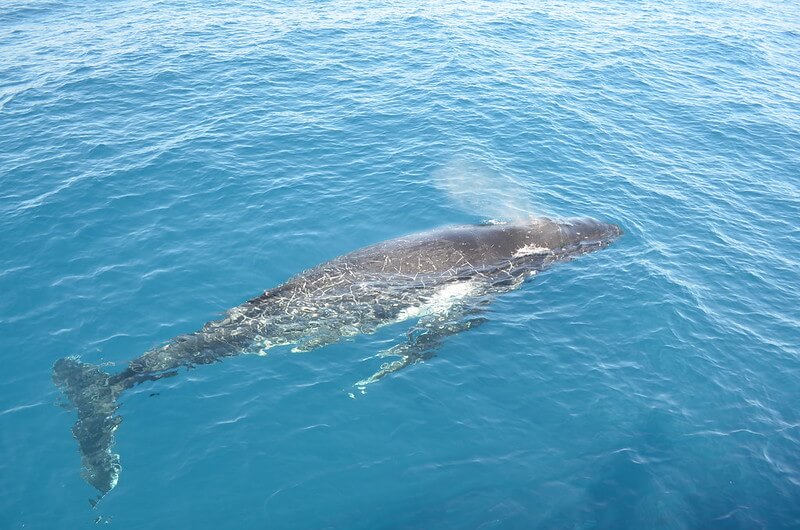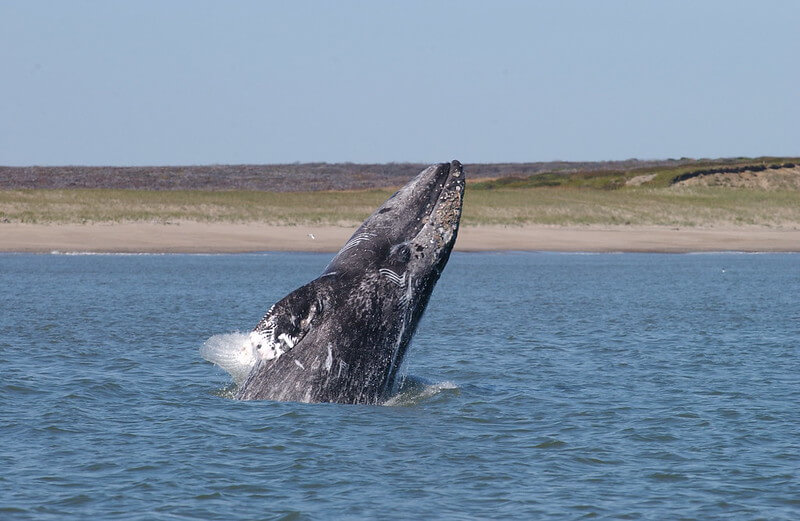Just like you and I, whales are mammals that are required to breathe air into their lungs to survive.
These ocean giants don’t have the luxury of breathing underwater like fish and sharks so they need to come to the surface every once in a while to breathe.
Most animals have noses that they use to smell and breathe, allowing them to take in oxygen through their nostrils and their mouth.
But what about whales? This brings up an interesting question that many people find themselves wondering. “Do whales have nostrils?”
YES, whales DO have nostrils, also known as a blowhole located at the top of their heads. This allows them to breathe without bringing their large bodies fully out of the water.
How Many Nostrils Do Whales Have?
The number of nostrils a whale has depends on the type of whale they are. Baleen whales have TWO nostrils on the top of their heads whereas toothed whales have only ONE nostril.
Nostrils are crucial for whales as they are unable to breathe out of their mouths.
Unlike terrestrial mammals, a whale’s digestive system and respiratory system are not connected so they rely heavily on their blowhole to breathe.
Killer whales are well aware of this. When hunting whales they will often leap on top of the whale to cover its blowhole and try to drown it.
It’s a fascinating ordeal and shows how incredibly intelligent killer whales are. They work together to block a whale’s blowhole whilst other members of the pod attack the whale elsewhere.
Where Are The Nostrils On A Whale?
Both toothed and baleen whales’ nostrils are located direction the top of their heads so that they can breathe.
Having nostrils on top of their heads brings a number of benefits for whales with the biggest being that they can breathe without fully breaking the surface of the water.
This means that they can surface for a brief second or two and take in another full breath which allows them to stay submerged again.
The length of time whales can hold their breath largely depends on the species, with deep-diving whales like the sperm whale being able to hold their breath the longest and others having to surface regularly.

Whilst traveling, most whales typically stay close to the surface as they are expending more energy and need to breathe more often.
A fascinating new study reveals how whale and dolphin skulls undergo a complete transformation through their embryonic and fetal development, resulting in a reorientation of their nasal passages.
Baleen and toothed whales move their nostrils to the top of their heads in the very early stages of development.
Whales transform their whole heads to change the direction of their nasal passage while keeping the snout facing forward.
A whale’s eyes, nose, and mouth are all there but they are completely disconnected from each other.
Why Do Whales Have Nostrils?
Whales are marine mammals that are required to breathe air into their lungs, and as they don’t breathe through their mouth they rely on their nostrils to do this.
Unlike fish, whales don’t have gills that would allow them to breathe underwater, therefore, they must return to the surface to breathe air.
A whale’s blowhole is situated at the top of the head and works very much like a valve.
When the whale submerges, the valve closes and stops air from entering, and when the whale returns to the surface the blowhole can be opened to expel air and take a breath.
The moisture that is released as the whale surfaces is often mistaken for being seawater that the whale is expelling from its lungs.
But this is actually moisture that is spouting from the blowhole and due to the temperature difference, a condensation effect occurs which makes it look like the whale is blowing out seawater.
If the whale was expelling seawater from its lungs it would be drowning, but this is a common misconception that is made when seeing whales resurface for air.
Do All Whales Have Nostrils?
YES, all whales have either ONE or TWO blowholes depending on the type of whale they are. As mentioned earlier, baleen whales have two nostrils whilst toothed whales have one.
Whales have full control over their blowhole which ensures that they can seal it shut just as they submerge and open it when needing to breathe.
It takes powerful muscles for whales to be able to open and close their blowhole. It’s crucial that whales remain in control of their blowhole as they need to continue breathing whilst they sleep.
They do this by sleeping close to the surface and shutting off one part of their brain at a time whilst the other gets some rest.

This allows whales to continue breathing even whilst getting some rest and will enable them to quite literally keep one eye open to be aware of any predators.
Final Thoughts
Hopefully, you now have a clear answer to “do whales have nostrils” and have a better understanding of how whales’ blowholes work.
A whale’s blowhole is crucial in allowing them to breathe when they come to the surface for air.
As these giant mammals don’t breathe through their mouth, blowholes allow them to take in air without needing to bring their enormous bodies fully out of the water.
The number of nostrils each species of whale has varies depending on whether it’s a baleen whale or a toothed whale.
Nevertheless, all whales do have nostrils as this is the only way they can breathe and survive in the ocean.
Without nostrils, a whale would not be able to breathe and therefore wouldn’t survive ocean life.
Thanks for taking time out of your day to learn more about whales and how they breathe.
Catch you in the next one!

Hi, I’m George – the founder of MarinePatch. I created this blog as marine wildlife has been my passion for many years. I’ve spent over a decade in the marine wildlife industry and spent years out in the field conducting research. In today’s modern world, an online blog is the best place for me to share my findings and reach as many people as possible to help educate and inspire others. Enjoy your time here and you’re welcome back anytime!

